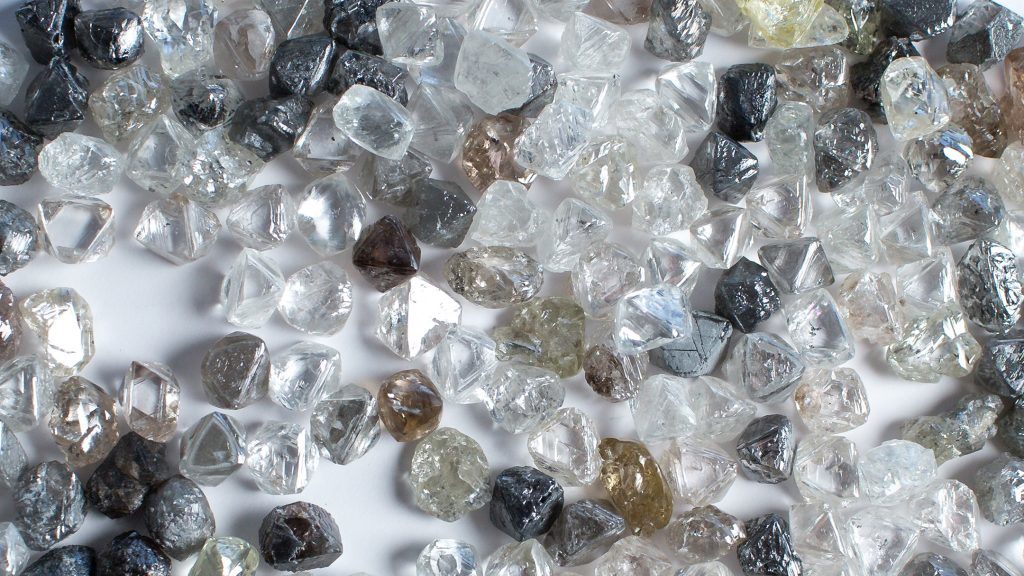Diamonds Across the Universe

Do you remember the first time you realized just how big and expansive the night sky was? For me, it happened when I was just a young child; I became enthralled with stars and other celestial objects that I could see without a telescope.I have fond memories of staring up for hours on end at the twinkling points of light until my neck hurt.
Brilliantly illuminated and breathtaking, I should’ve guessed that the cosmic wonders—including planets, asteroids, comets and even stars—have long been speculated to have similar compositions to diamonds, albeit in a different form than the precision faceted jewels we’ve come to cherish.
So what are these materials? And how do they form across our endless expanse of universe?
Turns out, it all comes down to three basic things with a huge byproduct: pressure, heat and carbon.
See, here on Earth, the deeper you go, the more the weight of Earth’s crust causes pressure to rise. And that in turn makes temperatures scorch. To get a better idea of what this means, pressure can be around 50,000 to 200,000 times more than what it is on the surface, and temperatures can reach thousands of degrees Celsius. These intense conditions cause atoms of carbon to pack together in a crystalline formation creating diamonds
Diamonds from Outer Space: Comets and Asteroids
Comets and asteroids carry within them iron, nickel, silicon and carbon. So it’s not surprising that scientists have found samples of “nanodiamonds” in many of them; there are examples of this in meteorites discovered in the Sudan, Russia, Mexico and all around the world.
While some of these crystals could have formed due to the immense pressure and heat caused by galactic collisions, others, which are much larger, are more likely to have formed inside of “protoplanets” hypothesized to be in a size range from our moon to a bit larger than Mars.
During the first ten million years of the solar system, these ancient celestial bodies collided with each other violently and often. Unlike the Earth, they never finished forming and eventually broke up. This is now what makes up the asteroid belt and Kuiper belt, along with some of our other “rocky” solar system neighbors.
Diamonds examined from the Almahata Sitta meteorite that came down in 2008 across the Nubian Desert, were multiple times larger than typically seen, and therefore believed to have origins in such a protoplanet.
Diamonds in the Sky: Stars and Planets
Ever heard of an entire planet, or even a star, made up entirely of diamonds? (Sounds pretty glamorous, huh?) Over the past few years, headlines stating such were regularly and excitedly announced. But after nearly a decade of scientists’ observations and calculations with telescopes including the Hubble and Spitzer Space Telescope, the true nature of these sparkling celestial bodies has become a bit clearer.
A planet around 40 light years away (so close that we can see its system’s star with the naked eye) named 55 Cancri e was originally thought to be a giant diamond twice the radius of Earth. Because of how close it orbits its star, the surface is incredibly hot—more than hot enough to create diamonds. And since its host star and system of five planets has been shown to be rich in carbon, scientists believe the planet now has a thick layer of diamond making up at least a third of the planet’s mass.
By contrast, our own planet and solar system is rich in silicates and oxygen, yet hasless than one part per 1000 of carbon.
Nearly 50 light years away from us in the constellation Centaurus, a white dwarf (a very dense star) is also suspected of being 90% diamond—or 10 billion trillion carats (!!!). Relatively “cold” at 4000 degrees Celsius, astronomy experts believe that the star’s carbon has significantly crystallized. if you ask me.
It’s Raining Diamonds
For over four decades now, physicists have theorized that in the atmospheres of Neptune and Uranus it “rains diamonds”. Earlier this year experiments were conducted to mimic the conditions on these ice giants that proved diamonds are forming there.
And the verdict is… it’s true! Scientists do in fact believe that diamonds are forming in the icy layer of these planets’ atmospheres where surprisingly violent storms occur. They may move up and down through the layers collecting mass, just like hail does here on Earth, until they rain down in the form of precipitation.
Also, as both Neptune and Uranus are believed to have solid rocky cores, it’s theorized that a diamond layer is probable in existence. Diamonds that are meters across and even “diamond bergs” might float in these exotic pressurized environments.
On Saturn and Jupiter, millions of tons of diamonds are thought to form after “cosmic thunderstorms”. They are expected to form after lightning turns carbon molecules in the atmosphere into soot. As falling into zones of higher pressure that turns into graphite (pencil lead) and after sinking a bit further (about the distance of 2.5 Earths) they transform into diamonds.
But much to our jewelry boxes’ dismay, it should be noted that these diamonds aren’t expected to be gem grade and are more like a “carbonado” material that is tough and opaque.
Of course, humans haven’t been to our outer planets just yet, and the last probe that we sent was Voyager 2. But an alignment in 2030 may set up an opportunity for a new mission to reach them by 2040. Maybe then we’ll discover more about the diamonds the universe is creating.
